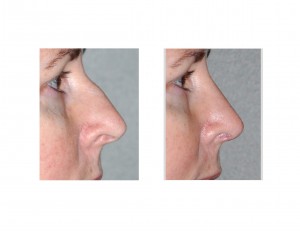Background: Combination internal nasal surgery to improve breathing and external nasal reshaping is commonly done. Technically this is known as a septorhinoplasty procedure. While the two nasal surgeries can be done separately and frequently are, one can always influence the other adversely. An overly done rhinoplasty can collapse the middle vault and narrow the internal valves and cause breathing impairment. An overly aggressive septal removal can result in collapse of the overlying nasal profile.
Nasal deviation is a common aesthetic nasal deformity. Many patients think that if they have a deviated septum that a septoplasty will also correct a crooked nose as well as improve their breathing. The reality is that nothing is further from the truth. When the nose is deviated or twisted, the structural problems are more than just a deviated septum. Almost all of the supporting nasal structures are deviated as well including the nasal bones and the upper and lower alar cartilages in many cases.
Rhinoplasty in the deviated nose is a challenging procedure. Getting a completely straight nose while performing external nose reshaping requires a complete ‘rebuild’ approach from the septum on out.
Case Study: This 47year-old female consulted for a rhinoplasty to reshape her nose. She had a twisted nose and a completely blocked left nasal airway. She had no history of any nasal trauma and her nose had been his way as long as she could remember.


Rhinoplasty can produce many nasal shape changes by manipulations of the nasal bones and alar cartilages. But when it comes to straightening the crooked nose, managing the septum becomes a critical component of the procedure. It is not only an important source for grafts but must be reshaped and straightened to serve as the central midline support fo the rest of the nose.
Case Highlights:
1) One of the most important steps is any rhinoplasty surgery is to either preserve nasal breathing or make it better.
2) Septal straightening and inferior turbinate reductions are often done in combination with external nose reshaping.
3) Spreader grafts of the middle vault and tip rotation are two rhinoplasty manuevers that can protect or improve nasal breathing.
Dr. Barry Eppley
Indianapolis, Indiana


